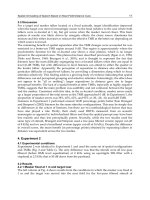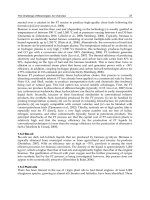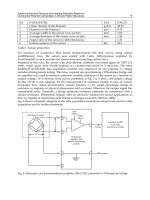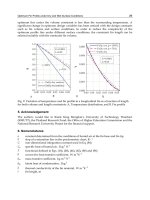A087 advanced concrete technology part 2 concrete properties
Bạn đang xem bản rút gọn của tài liệu. Xem và tải ngay bản đầy đủ của tài liệu tại đây (5.64 MB, 349 trang )
Advanced Concrete Technology
Advanced Concrete Technology
Constituent Materials
ISBN 0 7506 5103 2
Concrete Properties
ISBN 0 7506 5104 0
Processes
ISBN 0 7506 5105 9
Testing and Quality
ISBN 0 7506 5106 7
Advanced Concrete Technology
Concrete Properties
Edited by
John Newman
Department of Civil Engineering
Imperial College
London
Ban Seng Choo
School of the Built Environment
Napier University
Edinburgh
AMSTERDAM
PARIS
BOSTON
SAN DIEGO
HEIDELBERG
SAN FRANCISCO
LONDON
NEW YORK
SINGAPORE
OXFORD
SYDNEY
TOKYO
Butterworth-Heinemann
An imprint of Elsevier
Linacre House, Jordan Hill, Oxford OX2 8DP
200 Wheeler Road, Burlington MA 01803
First published 2003
Copyright © 2003, Elsevier Ltd. All rights reserved
No part of this publication may be reproduced in any material
form (including photocopying or storing in any medium by
electronic means and whether or not transiently or incidentally
to some other use of this publication) without the written
permission of the copyright holder except in accordance with the
provisions of the Copyright, Designs and Patents Act 1988 or under
the terms of a licence issued by the Copyright Licensing Agency Ltd,
90 Tottenham Court Road, London, England W1T 4LP. Applications for
the copyright holder’s written permission to reproduce any part
of this publication should be addressed to the publisher
Permissions may be sought directly from Elsevier’s Science and Technology Rights
Department in Oxford, UK: phone: (+44) (0) 1865 843830; fax: (+44) (0) 1865
853333; e-mail: You may also complete your request
on-line via the Elsevier homepage (), by selecting
‘Customer Support’ and then ‘Obtaining Permissions’
British Library Cataloguing in Publication Data
A catalogue record for this book is available from the British Library
Library of Congress Cataloguing in Publication Data
A catalogue record for this book is available from the Library of Congress
ISBN 0 7506 5104 0
For information on all Butterworth-Heinemann
publications visit our website at www.bh.com
Typeset by Replika Press Pvt Ltd, India
Printed and bound in Great Britain
Contents
Preface
List of contributors
xiii
xv
Part 1
1
Fresh concrete
Fresh concrete
P.L. Domone
1.1
1.2
1/3
Introduction
Workability
1.2.1
1.2.2
1.2.3
1.2.4
1.2.5
1.2.6
1.2.7
1.2.8
1.2.9
1/3
1/4
Terminology and definitions
Measurement of workability by quantitative empirical methods
Rheology of liquids and solid suspensions
Tests on cement paste
Tests on concrete
Relation of single-point test measurements to Bingham constants
Cohesion, segregation and stability
Quality control with rheological tests
Rheology of high-performance concrete
1.3 Loss of workability
1.4 Placing and compaction
1.5 Segregation and bleed after placing
References
Further reading
Relevant standards
1/4
1/5
1/11
1/13
1/16
1/19
1/21
1/21
1/22
1/23
1/24
1/25
1/26
1/27
1/28
vi
Contents
Part 2
2
Plastic and thermal cracking
Richard Day and John Clarke
2.1
2.2
2.3
2.4
2.5
2.6
2.7
2.8
2.9
2/3
Introduction
Plastic cracking
Plastic settlement cracks
2/3
2/5
2/5
2.3.1
2.3.2
2.3.3
2.3.4
2/5
2/6
2/8
2/8
The mechanism of plastic settlement
Visual appearance
Prevention of plastic settlement cracking
Remedial measures
Plastic shrinkage cracks
2.4.1
2.4.2
2.4.3
2.4.4
3
Setting and hardening of concrete
The mechanism of plastic shrinkage
Visual appearance
Prevention of plastic shrinkage
Remedial measures
2/9
2/9
2/10
2/11
2/11
Other cracks in plastic concrete
Early thermal contraction cracks
2/11
2/12
2.6.1
2.6.2
2.6.3
2.6.4
2/12
2/12
2/13
2/14
The mechanism of thermal contraction
Limiting temperatures
Control of cracking
Visual appearance
Curling
Crazing
2/14
2/14
2.8.1
2.8.2
2/14
2/15
The mechanism of crazing
Visual appearance
Long-term drying shrinkage cracks
2/15
2.9.1
2.9.2
2/15
2/16
The mechanism of long-term drying shrinkage
Visual appearance
References
Further reading
2/17
2/17
Curing
Bryan Marsh
3/1
3.1
3.2
3.3
3.4
3.5
3.6
3.7
3.8
Aims and objectives
What is curing?
Why cure concrete?
How can curing be achieved in practice?
Which curing method is best?
3/1
3/1
3/1
3/4
3/4
3.5.1
3.5.2
3.5.3
3.5.4
3.5.5
Retention of formwork
Impermeable coverings
Absorptive coverings
Water addition
Curing membranes
3/5
3/5
3/6
3/6
3/6
Protection against vibration
Is curing always effective?
How long should curing be applied?
3/7
3/8
3/8
3.8.1
3/8
The effect of cement type
Contents
4
3.9 When is curing of particular importance?
3.10 Effect of temperature
3.11 What happens if concrete is not cured properly?
3.12 The effect of curing on strength
3.13 The maturity concept for estimation of required curing duration
3.14 Some international curing specifications
3.15 Some food for thought
3.16 Summary and conclusions
References
Further reading
3/9
3/9
3/10
3/10
3/11
3/11
3/13
3/13
3/15
3/15
Concrete properties: setting and hardening
Tom Harrison
4/1
4.1
Strength development
4.1.1
4.1.2
4.1.3
4.1.4
4.1.5
4.1.6
4.1.7
4.2
4.3
5
4/1
Learning objectives
Background
Mechanism of strength development
Comparison of strength development
Temperature and temperature history
Curing conditions
Monitoring the rate of strength development
4/1
4/1
4/3
4/5
4/9
4/11
4/13
Maturity and accelerated curing
4/22
4.2.1
4.2.2
4.2.3
4.2.4
4.2.5
4.2.6
4.2.7
4.2.8
4/22
4/22
4/23
4/25
4/27
4/27
4/27
4/28
Learning objectives
Concept of maturity
Maturity laws
Calculations of maturity
Methods of obtaining data for maturity calculations
Applications of accelerated curing
Methods of accelerated curing
Effect of accelerated curing on concrete properties
Assessment of safe striking times
4/29
4.3.1
4.3.2
4.3.3
4.3.4
4.3.5
4/29
4/29
4/29
4/30
4/31
Learning objectives
Main external factors that affect striking times
Calculation of safe formwork striking times
Effects of the concrete on formwork striking times
Principal recommendations for formwork striking times
References
Further reading
4/31
4/33
Hot and cold weather concreting
E.A. Kay
5/1
5.1
5.2
5.3
Introduction
Hot weather concreting
5/1
5/1
5.2.1
5.2.2
Hot weather effects
Control measures
5/2
5/6
Cold weather concreting
5/11
5.3.1
5.3.2
5/11
5/12
Cold weather effects
Maturity
vii
viii
Contents
5.3.3
5.3.4
Heat transfer and heat loss
Control measures
5/13
5/13
References
5/18
Part 3
6
Strength and failure of concrete under short-term, cyclic
and sustained loading
John Newman
6.1
Deformation, fracture and failure
6.1.1
6.1.2
6.1.3
6.1.4
6.1.5
6.1.6
6.1.7
6.2
7
Properties of hardened concrete
6/3
6/3
The structure of concrete
Stresses and strains
Deformation and failure theories
Deformation of concrete
Modulus of elasticity (E-value)
Poisson’s ratio
Fracture and failure of concrete under uniaxial loading
6/3
6/3
6/4
6/8
6/9
6/10
6/10
Behaviour of concrete under multiaxial stresses
6/22
6.2.1
6.2.2
6.2.3
6.2.4
6.2.5
6/22
6/23
6/25
6/26
6/28
Introduction
Transmission of load through different materials
Choice of loading technique
Behaviour of concrete under biaxial stress
Behaviour of concrete under triaxial stress
References
6/35
Elasticity, shrinkage, creep and thermal movement
Jeff Brooks
7/1
7.1
7.2
7.3
7.4
7.5
Learning objectives
Introduction
Elasticity
Shrinkage
7/1
7/1
7/2
7/3
7.4.1
7.4.2
7.4.3
7.4.4
7.4.5
7.4.6
7.4.7
7/3
7/4
7/5
7/5
7/7
7/8
7/9
Structure of cement paste
Mechanism of shrinkage
Measurement of shrinkage
Factors in shrinkage
Carbonation shrinkage
Prediction of shrinkage
Effects of drying shrinkage
Creep
7.5.1
7.5.2
7.5.3
7.5.4
7.5.5
7/9
Measurement of creep
Mechanism of creep
Factors in creep
Prediction of creep
Effects of creep
7.6 Thermal movement
7.7 Summary
References
7/12
7/12
7/13
7/15
7/16
7/17
7/17
7/18
Contents
Part 4
8
Durability of concrete and concrete construction
Durability concept: pore structure and transport processes
Lars-Olof Nilsson
8.1
8.2
8.3
8.4
Introduction
Durability concept
Forms of physical and chemical deterioration
Transport processes
8.4.1
8.4.2
8.4.3
8.4.4
8.4.5
8.4.6
8.4.7
8.4.8
8.4.9
9
Significance of transport processes
Transport mechanisms
Transport laws in general
Moisture transport
Carbonation
Chloride ingress
Boundary conditions
Transport properties of site concrete
Methods for measuring transport properties
8/3
8/3
8/3
8/5
8/5
8/5
8/6
8/8
8/9
8/16
8/17
8/22
8/23
8/24
8.5 Summary and conclusions
References
Further reading
8/26
8/27
8/28
Reinforcement corrosion
G.K. Glass
9/1
9.1
9.2
9.3
9.4
9.5
9.6
9.7
9.8
ix
Introduction
The corrosion process
The concrete environment
Stages in the deterioration process
Carbonation-induced corrosion
9/1
9/2
9/4
9/5
9/6
9.5.1
9.5.2
9/6
9/8
Concrete carbonation
Corrosion initiation and propagation
Chloride-induced corrosion
9/10
9.6.1
9.6.2
9.6.3
9/10
9/11
9/12
Chloride contamination
Modelling chloride penetration
Chloride-induced corrosion initiation
Other causes of corrosion
Corrosion rate
9/15
9/16
9.8.1
9.8.2
9.8.3
9.8.4
Typical values
Anodic control
Cathodic and resistive control
Factors affecting the corrosion rate
9/16
9/16
9/17
9/18
9.9 Monitoring corrosion
9.10 Repair of corrosion-damaged concrete
9/18
9/21
9.10.1
9.10.2
9.10.3
9.10.4
Diagnostic approach
Functional requirements
Repair options
Technical requirements
9.11 Summary
References
9/21
9/22
9/22
9/23
9/25
9/25
x
Contents
10 Concrete and fire exposure
Bob Cather
10/1
10.1 Essentials of concrete behaviour
10.2 Strength loss in the cement matrix
10.3 Spalling
10.4 The influence of aggregate type
10.5 High-strength concrete
10.6 Essentials of steel behaviour
10.7 Fire behaviour and design codes
10.8 Fire types and heat exposure
10.9 Behaviour of concrete in extreme fires
10.10 Improving the fire resistance of concrete
10.11 Evaluation of concrete structures exposed to fire
References
10/1
10/2
10/3
10/4
10/4
10/5
10/6
10/7
10/8
10/9
10/10
10/12
11 Freeze/thaw resistance
Michel Pigeon, Bruno Zuber and Jacques Marchand
11/1
11.1 Introduction
11.2 Mechanisms of ice formation in cementitious materials
11.3 Mechanisms induced by ice formation
11.4 Laboratory testing and influence of various parameters
11.5 De-icer salt scaling
11.6 Air entrainment
11.7 Special concretes
11.8 Field performance
References
11/1
11/2
11/5
11/7
11/9
11/12
11/14
11/15
11/16
12 Acid, soft water and sulfate attack
Steve Kelham
12/1
12.1 Aqueous solutions
12/1
12.1.1 Pure water, pH, acids, bases
12.1.2 Strong acids, weak acids, soft water
12.1.3 Sulfate solutions, sea water
12/1
12/2
12/3
12.2 Reactions of water and acids with concrete/mortar
12/3
12.2.1 Leaching
12.2.2 Reactions of hydration products with acids
12/3
12/3
12.3 Factors affecting rate of attack by water and acids
12.3.1
12.3.2
12.3.3
12.3.4
12/3
Solution chemistry, solution availability
Concrete quality
Cement type
Aggregates
12/3
12/4
12/4
12/4
12.4 Reactions of sulfate solutions with concrete
12/4
12.4.1
12.4.2
12.4.3
12.4.4
Aluminate hydrates, ettringite (AFt), monosulfate (AFm)
Delayed ettringite formation
Reactions with external sulfate
Thaumasite formation
12/4
12/5
12/5
12/6
Contents
12.5 Test methods and results
12/6
12.5.1 Natural exposure tests
12.5.2 Accelerated laboratory tests
12.5.3 Testing cements
12/6
12/7
12/7
12.6 Specifying concrete for acid, soft water and sulfate exposures
12.6.1 Classifying exposure conditions, water, soil
12.6.2 Concrete quality, cement types
12.6.3 DEF
12/9
12/9
12/10
12/11
References
12/12
13 Alkali–aggregate reactivity
Ian Sims and Alan Poole
13/1
13.1 Introduction
13/1
13.1.1 Background
13.1.2 Reaction types
13/1
13/2
13.2 Reaction mechanisms
13/3
13.2.1 Alkali–silica reactivity
13.2.2 Alkali–carbonate reactivity
13/3
13/10
13.3 Effects of AAR
13/11
13.3.1 Concrete properties
13.3.2 Structures
13/11
13/11
13.4 Cases of AAR
13/14
13.4.1 Europe and the UK
13.4.2 Outside Europe
13/14
13/17
13.5 Diagnosis and prognosis
13/18
13.5.1
13.5.2
13.5.3
13.5.4
Inspection and monitoring
Sampling
Laboratory investigation
Structure appraisal
13/18
13/19
13/19
13/23
13.6 Minimizing risk and prevention
13.6.1
13.6.2
13.6.3
13.6.4
13/25
Schemes
Aggregate assessment
Major preventative options
Alternative preventative options
13/25
13/26
13/28
13/29
13.7 Repairs and remedies
13/32
13.7.1 Principles
13.7.2 Coatings and treatments
13.7.3 Strengthening
13/32
13/33
13/33
References
Further reading
13/34
13/37
14 Specification and achievement of cover to reinforcement
Bryan Marsh
14.1
14.2
14.3
14.4
14.5
xi
Aims and objectives
Introduction
Specification of cover
Achievement in practice
Reliability and workmanship
14/1
14/1
14/1
14/2
14/3
14/4
xii
Contents
14.6 Excessive cover
14.7 Future specification of cover
14.8 Durability design
14.9 Performance testing
14.10 Recommendations for achievement of cover
14.11 Measurement of cover
14.12 Action in the event of non-conformity
14.13 Examples of non-compliance
14.14 Recent research
14.15 Alternative approaches to ensuring durability
References
Further reading
Index
14/4
14/4
14/5
14/5
14/6
14/7
14/7
14/7
14/8
14/8
14/8
14/9
I/1
Preface
The book is based on the syllabus and learning objectives devised by the Institute of
Concrete Technology for the Advanced Concrete Technology (ACT) course. The first
ACT course was held in 1968 at the Fulmer Grange Training Centre of the Cement and
Concrete Association (now the British Cement Association). Following a re-organization
of the BCA the course was presented at Imperial College London from 1982 to 1986 and
at Nottingham University from 1996 to 2002. With advances in computer-based
communications technology the traditional residential course has now been replaced in
the UK by a web-based distance learning version to focus more on self-learning rather
than teaching and to allow better access for participants outside the UK. This book, as
well as being a reference document in its own right, provides the core material for the
new ACT course and is divided into four volumes covering the following general areas:
• constituent materials
• properties and performance of concrete
• types of concrete and the associated processes, plant and techniques for its use in
construction
• testing and quality control processes.
The aim is to provide readers with an in-depth knowledge of a wide variety of topics
within the field of concrete technology at an advanced level. To this end, the chapters are
written by acknowledged specialists in their fields.
The book has taken a relatively long time to assemble in view of the many authors so
the contents are a snapshot of the world of concrete within this timescale. It is hoped that
the book will be revised at regular intervals to reflect changes in materials, techniques
and standards.
John Newman
Ban Seng Choo
This Page Intentionally Left Blank
List of contributors
Jeff Brooks
Department of Civil Engineering, University of Leeds, Leeds LS2 9JT, UK
Bob Cather
Arup Research and Development, 13 Fitzroy Street, London W1T 4BQ, UK
John Clarke
The Concrete Society, Century House, Telford Avenue, Crowthorne, Berkshire
RG45 6YS, UK
Richard Day
The Concrete Society, Century House, Telford Avenue, Crowthorne, Berkshire
RG45 6YS, UK
P.L. Domone
Department of Civil and Environmental Engineering, University College London, Gower
Street, London WC1E 6BT, UK
G.K. Glass
Fosroc Construction Group Development, Coleshill Road, Tamworth, Staffordshire
B78 3TL, UK
Tom Harrison
Quarry Products Association, Century House, Telford Avenue, Crowthorne, Berkshire
RG45 6YS, UK
E.A. Kay
Halcrow Group Ltd, Vineyard House, 44 Brook Green, London W6 7BY, UK
xvi
List of contributors
Steve Kelham
Lafarge Cement UK, 305 London Road, Greenhithe, Kent DA9 9JQ, UK
Jacques Marchand
Department of Civil Engineering, Université Laval, Québec, Canada G1K 7P4
Bryan Marsh
Arup Research and Development, 13 Fitzroy Street, London W1T 4BQ, UK
John Newman
Department of Civil Engineering, Imperial College, London SW7 2BU, UK
Lars-Olof Nilsson
Division of Building Materials, Lund University of Technology, Lund, Sweden
Michel Pigeon
Department of Civil Engineering, Université Laval, Québec, Canada G1K 7P4
Alan Poole
Parks House, 1D Norham Gardens, Oxford OX2 6PS, UK
Ian Sims
STATS Consultancy, Porterswood House, Porterswood, St Albans AL3 6PQ, UK
Bruno Zuber
Department of Civil Engineering, Université Laval, Québec, Canada G1K 7P4
PART 1
Fresh concrete
This Page Intentionally Left Blank
1
Fresh concrete
P.L. Domone
1.1 Introduction
Fresh concrete is a transient material with continuously changing properties. It is, however,
essential that these are such that the concrete can be handled, transported, placed, compacted
and finished to form a homogenous, usually void-free, solid mass that realizes the fullpotential hardened properties. A wide range of techniques and systems are available for
these processes, and the concrete technologist, producer and user must ensure that the
concrete is suitable for those proposed or favoured.
Fresh concrete technology has advanced at a pace similar to many other aspects of
concrete technology over the past three decades, and indeed many of these advances have
been inter-dependent. For example, the availability of superplasticizers has enabled workable
concrete to be produced at lower water/binder ratios thus increasing the in-situ strength.
In this chapter, we will start by considering the property known as workability*,
including its definition and common methods of measurement. We will point out the
limitations of these, and show how this leads to the need for a more fundamental scientific
description of the behaviour of fresh cement pastes and concrete. We will then describe
how this has been achieved by applying the principles of rheology, and explain the
development and use of test methods which give a more complete understanding of the
behaviour. We will then discuss the effect on the rheological properties of a range of
constituent materials, including admixtures and cement replacement materials, and how
a knowledge of these properties can be used to advantage. The factors that influence the
loss of workability before setting are then briefly considered.
*The alternative term ‘consistence’ is often used, particularly in specifications and standards.
1/4
Fresh concrete
We will not discuss the specific properties required for particular handling or placing
techniques such as pumping, slipform construction, underwater concreting etc. These are
covered in various chapters in Volume 3 of this series, but hopefully the more general
description given in this chapter will be of value when reading these. We will, however,
describe the principles of ensuring that the concrete is correctly placed and compacted to
give a uniform, homogenous result. Finally, we will discuss the behaviour of the concrete
after placing but before setting, with particular reference to segregation and bleed.
1.2 Workability
1.2.1 Terminology and definitions
Problems of terminology and definition are immediately encountered in any discussion
of the fresh properties of concrete. Every experienced concrete technologist, producer
and handler has an understanding of the nature and properties of the material, and can
choose from a wide variety of terms and expressions to describe it; examples include
harsh, cohesive, lean, stiff, rich, etc. Unfortunately, all these terms, and many others, are
both subjective and qualitative, and even those that purport to be quantitative, e.g. slump,
give a very limited and sometimes misleading picture, as we will see. This is not to say
that such terms and values should not be used, but that they must be used with caution,
particularly when trying to describe or specify the properties unambiguously.
A satisfactory definition of workability is by no means straightforward. Over 50 years
ago, Glanville, et al. (1947), after an extensive study of fresh concrete properties, defined
workability as ‘the amount of work needed to produce full compaction’, thereby relating
it to the placing rather than the handling process. A more recent ACI definition has
encompassed other operations; it is ‘that property of freshly mixed concrete or mortar
which determines the ease and homogeneity with which it can be mixed, placed, consolidated
and finished’ (ACI, 1990). This makes no attempt to define how the workability can be
measured or specified. A similar criticism applies to the ASTM definition of ‘that property
determining the effort required to manipulate a freshly mixed quantity of concrete with
minimum loss of homogeneity’ (ASTM, 1993).
Such definitions are clearly inadequate for the description, specification and quality
control of fresh concrete, and many attempts have been to provide a more satisfactory
definition which includes quantitative measurements. These are sometimes more restrictive,
for example the ACI (1990) definition of consistency as ‘the relative mobility or ability
of freshly mixed concrete to flow’, which is measured by the slump test. This difficulty
illustrates that no single test or measurement can properly describe all of the required
properties of the fresh concrete.
(Tattersall 1991) has proposed a division of the terminology relating to workability
into three classes:
Class 1:
Class 2:
Qualitative, to be used in a general descriptive way without any attempt to
quantify, e.g. workability, flowability, compactability, stability, pumpability.
Quantitative empirical, to be used as a simple quantitative statement of behaviour
in a particular set of circumstances, e.g. slump, flow table spread.
Fresh concrete
Class 3:
1/5
Quantitative fundamental, to be used strictly in accordance with the definitions
in BS 5168: Glossary of rheological terms, e.g. viscosity, mobility, fluidity,
yield value.1
Such a division is helpful in that it clearly exposes the limitations of many of the terms,
and it will be useful to keep this in mind when reading this chapter.
1.2.2 Measurement of workability by quantitative
empirical methods
Many tests have been devised and used over many years to produce quantitative empirical
values in Class 2 above. They give a single measurement, and are therefore often referred
to as ‘single-point’ tests, to distinguish them from the ‘two-point tests’ which give two
measurements, and which we will describe later.
As long ago as 1947, twenty-nine single-point tests were described as the more important
of those developed up to that time (Glanville et al., 1947). A recent compendium of tests
has included sixteen single-point tests, and therefore at least this number are likely to be
in current use (RILEM, 2002). Few, if any, of the tests described are suitable for the
complete range of workabilities used in practice. Indeed, many have been developed in
the past two decades in response to the use of increasingly higher workability concrete,
including, most recently, self-compacting concrete.
Four tests have a current British Standard: slump, compacting factor, Vebe and flow
table (or more simply, flow), and will now be discussed together with the slump flow test,
an adaptation of the slump test for self-compacting concrete, and the degree of compactability
test, which has replaced the compacting factor test in the recent European Standards. The
tests are shown and described in Figures 1.1–1.6. Table 1.1 gives the principles on which
they operate, and some comments on their use.
The slump test (Figure 1.1), which is simple, quick and cheap, is almost universally
used for nearly all types of medium and high workability concrete. As well as the drawbacks
listed in Table 1.1, there are also some differences in practice with its use in different
countries, particularly with respect to the British and American standards.
First, the British and European Standards specify that the slump should be measured
to the highest point of the concrete, whereas the American standard specifies measurement
to the displaced original centre of the top surface of the concrete (as shown in Figure 1.1).
Clearly, the same test on the same concrete can give different values depending on where
it is performed.
Second, the British standard only recognizes values from a true slump as valid, and
does not allow recording of values from either shear or collapsed slump (Figure 1.1); the
American standard includes a similar restriction for shear slump, but allows measurements
of a collapsed slump, and values of 250 mm and above are often reported. The recent
European standard states that the test is sensitive to changes in consistency corresponding
to slumps between 10 and 200 mm, and the test is not considered suitable beyond these
extremes.
The flow table (Figure 1.4) test was introduced initially to German standards when
superplasticizers and high workability flowing concrete (i.e. collapsed slump) started to
1
A list of the relevant standards can be found at the end of the chapter.
1/6
Fresh concrete
Table 1.1 Common single-point workability tests
Test
Principle
Comments
Slump (Figure 1.1)
measures a flow property of
concrete under self-weight
after standard compaction
•
•
•
•
Compacting
factor
(Figure 1.2)
measures the effect of a
standard amount of work
(height of fall) on compaction
• suitable for low, medium and high
workability mixes
• fairly simple, but requires scales
• less operator dependent than slump
Vebe
(Figure 1.3)
measures the amount of work
(time at constant vibration)
for full compaction
• suitable for very low and low workability mixes
• greater relation to concrete placing
conditions than slump
• more complex than other methods, requires
standard vibrating equipment
• sometimes difficult to define end point
Flow table
(Figure 1.4)
measures the effect of a
standard amount of work
(bumps) on spread
• suitable for high and very high workability
mixes
• gives some indication of tendency of mix to segregate
• fairly simple, but, like slump, operator dependent
Slump flow
(Figure 1.5)
as in the slump test, measures
a flow property of concrete
under self-weight, but after
self-weight compaction
• developed for self-compacting concrete
• very simple, suitable for site use
• operator dependent, but less so than slump
Degree of
compactability
(Figure 1.6)
measures the effect of a
standard amount of work
(dropping the concrete from
the edge of the container) on
compaction
• an alternative to the compacting factor test
• simple, suitable for site use
• likely to be operator dependent
suitable for medium and high workability concrete
sensitive to small changes in water content
very simple, suitable for site use
heavily operator dependent
Slump:
100
British and European
standards
American
standard
300
200
1. The cone is filled with
concrete in three equal
layers, and each layer is
compacted with twenty-five
tamps of the tamping rod.
True
2. The cone is slowly
raised and the
concrete is allowed to
slump under its own
weight.
Shear
3. The slump is
measured using the
upturned cone and
slump rod as a
guide
Collapse
Types of slump
Figure 1.1 The slump test (BS 1881 Part 102: 1983; BS EN 12350-2: 2000; ASTM C 143-90a).
Fresh concrete
1/7
Upper
hopper
Lower
hopper
App. 1 metre
300 × 150 mm
φ cylinder
1.
2.
3.
4.
5.
6.
7.
Concrete is loaded into the upper hopper
The trap door is opened, and the concrete falls into the lower hopper
The trap door is opened, and the concrete falls into the cyinder
The concrete is struck off level with the top of the cylinder
The cylinder + concrete is weighed, to give the partially compacted weight of concrete
The cylinder is filled with fully compacted concrete
The cylinder + concrete is weighed, to give the fully compacted weight of concrete
Compacting factor =
weight of partially compacted concrete
weight of fully compacted concrete
Figure 1.2 The compacting factor test (BS 1881 Part 103: 1993).
Clear
perspex
disc
Vibration
300 mm
1. A slump test is performed in a
rigid container
2. A clear perspex disc, free to
move vertically, is lowered onto
the concrete surface
3. Vibration at a standard rate is
applied with a vibrating table
Vebe degrees is the time
(in seconds) to complete
covering of the underside
of the disc with concrete
Figure 1.3 The Vebe test (BS 1881 Part 104: 1983, BS EN 12350-3: 2000).
1/8
Fresh concrete
‘Flow’
200
Dimensions in mm
130
Stop
200
40
Hinge
700
1. A conical mould (2/ 3 the height of that in the slump test) is used to produce a sample of
concrete in the centre of a 700 mm square board, hinged along one edge
2. The free edge of the board is lifted against the stop and dropped 15 times
Flow = final diameter of the concrete
(mean of two measurements at right angles)
Figure 1.4 The flow table test (BS 1881 Part 105: 1984, BS EN 12350-5: 2000).
Slump flow
1. A slump cone (see Figure 1.1) is filled without compaction
2. The cone is lifted and the slump flow is final diameter of spread
(mean of two diameters at right angles)
3. The time to reach a spread of 500 mm is sometimes also measured
4. The baseboard must be smooth, clean and level
Figure 1.5 The slump flow test.
become popular in the 1970s. However, this test was criticized (Dimond and Bloomer,
1977) even before its first inclusion in British Standards in 1983, for several reasons,
including:
• The test is operator sensitive, potentially more so than the slump test;
• When the spread exceeds 510 mm, the recommended minimum for flowing concrete
(Cement and Concrete Association, 1978), the concrete thickness is about the same as
a 20 mm aggregate particle, and the test cannot therefore be a satisfactory measure of
the bulk concrete properties;
• There is a high degree of correlation between the initial spread before jolting and the
final spread after jolting, and thus no extra information is gained by the jolting.









